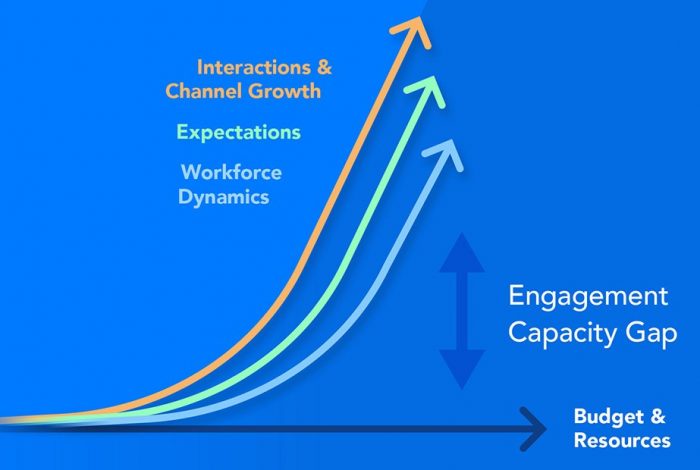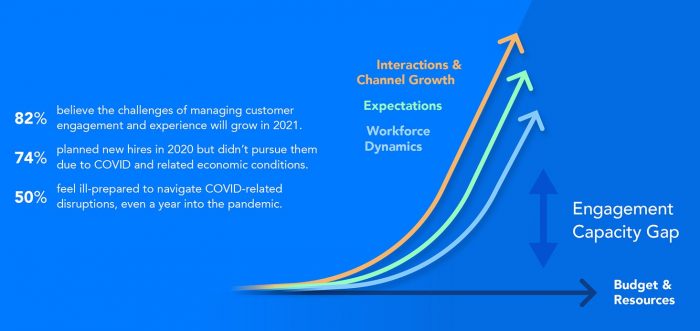
What a year it has been. Thinking back to last March, the first cases of Coronavirus were spreading, and the world collectively recognized that a global pandemic was well underway. Our executive team was days away from transitioning our global team of 6,000 to remote working, locking down travel, and activating plans to assist our customers in adapting and responding to the crisis. 2020 was the year that put business as usual to the test and forced a change in consumer behavior that resulted in a permanent impact on the customer journey across every industry.
In my role as VP Global Customer Experience, I heard first-hand how companies moved to remote operations within weeks or even days, pivoted to support a different business model, supported increasing digital interactions and call volumes, and quickly deployed critical self-service tools to help mitigate the sudden increase in consumer demand. As the pace of digital transformation accelerated, customer expectations increased, resources dwindled and these trends became the new normal, we decided to press pause and understand how these changes affected business operations and priorities and rethink how to engage with customers in new ways.
My company conducted a study in conjunction with an independent research firm in late 2020 to reveal how business leaders are addressing rising customer expectations and a rapidly changing workforce. What are their challenges? What are their biggest concerns? Are they prepared for 2021? We surveyed thousands of business leaders from around the world across 10 industries and found that there’s an expanding gap between what customers now expect and what brands can deliver. This new trend is called the Engagement Capacity Gap™ and needs to be top of mind for business leaders and customer experience professionals in 2021.
What is the Engagement Capacity Gap?
The research quantifies and illuminates a widening Engagement Capacity Gap brought about by new workforce dynamics, ever-expanding customer engagement channels, and exponentially more consumer interactions – all of which must be managed with a limited budget and resources. This is the perfect storm for CX practitioners and contact center leaders who now have to navigate massive digital disruption and increased customer expectations while their organizations are unable to keep up with these latest trends.
Organizations reported at the beginning of 2020 that they already lacked the resources to keep up with rising consumer demands. The pandemic added even more pressure: 82 percent believed the challenges of managing customer engagement and experience will grow in 2021. About three-quarters of respondents planned new hires in 2020 but didn’t pursue them due to COVID and related economic conditions. Half of those surveyed feel ill-prepared to navigate COVID-related disruptions, even a year into the pandemic.

The survey also found that top concerns and business priorities have shifted. A staggering 94% of business leaders are concerned about how to understand and act on rapidly changing customer behaviors while 88% said managing the growth in the volume of customer interactions is challenging. More than three-quarters of respondents are also concerned with having a unified view of customer engagement and overcoming data silos.
These concerns are impacting business priorities for 2021 bringing customer engagement to the top of the list. Some organizations understand that to get through these challenges, they will have to focus on creating differentiated experiences. The survey found that 51 percent of respondents plan to increase customer support professionals’ skills and knowledge while 49 percent plan to evolve customer experience and customer engagement strategies to recognize new challenges.
Given all these new trends, the role of artificial intelligence (AI) appears to still be a priority with 78 percent of business leaders reporting a moderate-to-high investment in AI. However, only 18 percent say AI has helped their organization manage shifts in channel usage and interaction volume. AI has the potential to drive better engagement while continuously lowering costs, allowing companies to deliver differentiated experiences and optimize the human touch at scale. For many business leaders, AI isn’t delivering on those promises just yet.
Closing the Gap in 2021
I think it’s safe to say that 2021 is the year to close the Engagement Capacity Gap with customer engagement becoming the essential force for navigating this inflection point. So what do we have to do to close the gap?
Business leaders believe customer engagement is a key competitive differentiator in 2021. They’re not wrong. McKinsey wrote recently that organizations that create a distinctive customer experience will recover faster from the pandemic.
Organizations seem to understand that they must:
- Create differentiated experiences that are authentic, relevant, frictionless, and connected.
- Deliver across billions of interactions, hundreds of journeys, and dozens of channels and touchpoints.
- Maintain and empower a new workforce of bots and humans working from anywhere.
- Achieve all these goals with limited resources and without breaking the budget.
While these objectives provide a clear path to closing the gap, they are easier said than done. The good news is advanced technology solutions are being adopted and implemented according to the research results. When it comes to the customer engagement technologies organizations considered most critical in 2020, 85 percent agreed that cloud-based solutions helped in managing shifts in channel usage and interaction volumes to a moderate or high degree. Moving forward, 88 percent of respondents say they expect to invest to a high or moderate degree in cloud-based customer engagement and experience solutions to close the Engagement Capacity Gap. Leaders plan to invest most in customer engagement solutions, such as workforce management, and chatbots or intelligent virtual assistants, and solutions to support compliance.
I recently hosted a webinar with customer experience expert Colin Shaw, who has some fresh ideas on how to achieve these new objectives. According to Colin, there’s a massive opportunity now to enter the new world and build the right experiences that customers want through customer science.
He explained:
“AI and machine learning will play a key role in improving CX moving forward. Let’s think about customer loyalty as a function of memory. You can’t be loyal to something that you don’t remember. To create loyal customers, you have to understand how memories are formed. Organizations aren’t capturing that right now because that data lives in different silos. Organizations need to collect and analyze that data to build a memory map that captures the customer’s memory of interactions. We need to dig into customer psychographics using AI and behavioral science to better understand what motivates them. It’s then that we can predict what customers are going to do next and better address their needs.”
Moving forward, companies must push beyond the traditional way of thinking about CX. Today, everyone in the organization should focus on delivering exceptional experiences, not just the customer experience and contact center teams. That means eliminating data silos by investing in the right technologies to gain a better understanding – and predicting – customer behaviors and expectations. It means working with the right technology vendor who can implement and manage integrated solutions that collect and analyze data across the organization. And it means providing employees with the knowledge, technology and tools to deliver exceptional experiences.



